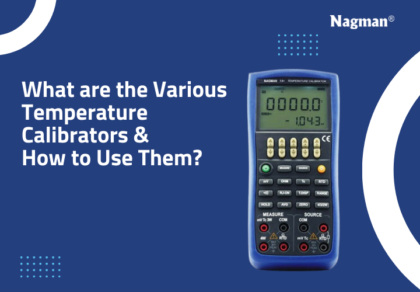Temperature calibrators are advanced devices that can replicate the process of temperature sensors, which have the nominal range commonly called the point of uncertainty or accuracy. It’s often referred to as a thermometer that monitors the change in temperature readings. Numerous devices in the market resemble the functionality of temperature calibrators. Here is the list of some to make a note of:
- Thermometer Calibrator
- Temperature Simulator
- Thermocouple Furnace
- Temperature Indicator
- Infrared Thermometer
- Black Body Calibrator
- Dry Block Calibrator
- Pyrometers
- Stirred Baths
- Universal Dry Block Low-Temperature Calibrator
- Dual Dry Block (Hot & Cold) Temperature Calibrator
- Medium Temperature Dry Block Calibrator
- Metrological Dry Block Medium Temperature Calibrator
Irrespective of its type, the defined function of the temperature calibrator is similar. It also has the operational feature of sourcing & locating errors of any device that can measure equipment temperature. Are you looking to protect your valuable device against temperature uncertainties and excess heating? Then, this article is for you. Here, we delve deeper to understand the various types of temperature calibrators to discover why they are necessary during high-end operations & how to use them.
Different Types Of Temperature Calibrators – All You Need To Know!
In equipment calibration, the deployed temperature sensors are spread across different ranges & types. For industrial temperature measurements, 3 different variants of temperature calibrators have been used. Let’s discuss everything in detail.
Temperature Sensor Calibration:
- The calibration of the temperature sensors verifies the total offsets from the absolute measurements reading & saves that offset.
- For registering precise measurements, the temperature sensor is placed on the equipment that requires exact device tuning to measure the output of the sensor offset.
- Temperature calibration is usually performed at specified regions. Some well-known dry block temperature calibrators are available in variants like ultra negative, sub-zero temperature, stirred baths & much more. As the name suggests, dry block performs calibration without requiring any fluid and implies DUT sensors for measurement.
Instrument Calibration:
- It’s a traditional calibration mode, where the output derived from the instrument calibrator is similar to the trigger sensor output. But it may drift after a specific timeframe.
- The operations are identical to temperature sensors that read process temperature.
- The device’s offset can be viewed & modified to quantify its previously measured accuracy.
- Every single device must undergo regular quality testing protocols. That’s why having a test and measuring instrument becomes vital. It can calculate important parameters like voltage, resistance, temperature, pressure, RTD, vacuum & lot more.
System Calibration:
- System calibration is a much simpler process that validates the proper functioning of the entire system, from gathering inputs to high-yield outputs with accuracy.
- The operation is a combined version of the temperature sensor & instrument calibration.
- The system calibrator can read the system temperature at every stage. It can be deployed in industrial control systems such as control servers, industrial automation & control systems (IACS), programmable logic & automation controllers (PLC/PACs), distributed control systems (DCS), remote terminal units (RTUs) & much more.
Process Involved In Temperature Sensor Calibration:
During incision, temp sensors are tested & calibrated, and the end values are stored. Then, the sensors are modified to check whether they meet the desired temperature by testing again. For precise calibration, follow these step-by-step processes:
- Place the reference & calibration probe RTD in the temperature bath.
- Connect the sensor leads to notify the final probe reading and pair with the probe.
- The temperature of the reference & calibrating probe is recorded for every test region.
- As part of the calibration, the probe’s resistance is valued & new parameters are calculated.
- Notify the device error under test/calibrating probe RTD to check whether it’s intolerant.
- Using the final results, check the latest values for calibrating probes like RTD/PRT.
Why is deploying Temperature Calibrators Necessary?
If calibrating a temperature sensor is challenging, choosing the desired calibration device is even tiresome. It can be accomplished by understanding the use cases of each calibrating instrument discussed briefly in this article. But the first step is to be aware of the thermometer that is being calibrated, which includes knowing the physical features, electrical signal types, temperature range, etc. Are you looking for the right kind of temperature calibrator for your equipment? Nagman has a perfect solution for you. Reach out to us NOW!



